Wind Power Generator Market Research, 2032
The global wind power generator market growth is valued at $21.4 billion in 2022, and is projected to reach $35.4 billion by 2032, growing at a CAGR of 5.2% from 2023 to 2032.
Report Key Highlighters:
- The report outlines the current wind power generator market trends and future scenario of the market from 2022 to 2032 to understand the prevailing opportunities and potential investment pockets.
- The global wind power generator market has been analyzed in terms of value ($Million). The analysis in the report is provided on the basis of installation, application, end use industry, 4 major regions, and more than 15 countries.
- The wind power generator market is fragmented in nature with few players such as Siemens, GE, Vestas, Goldwind, Enercon, Samsung Electronics, United Power, Inc., Ming Yang, Senvion, and Nordex Group, which hold significant share of the market.
- The report proivdes strategy planning and industry dynamics to enhance decision making for existing market players and new entrants entering the wind power generator industry.
- Countries such as China, U.S., India, Germany, and Brazil hold a significant share in the global wind power generator market.
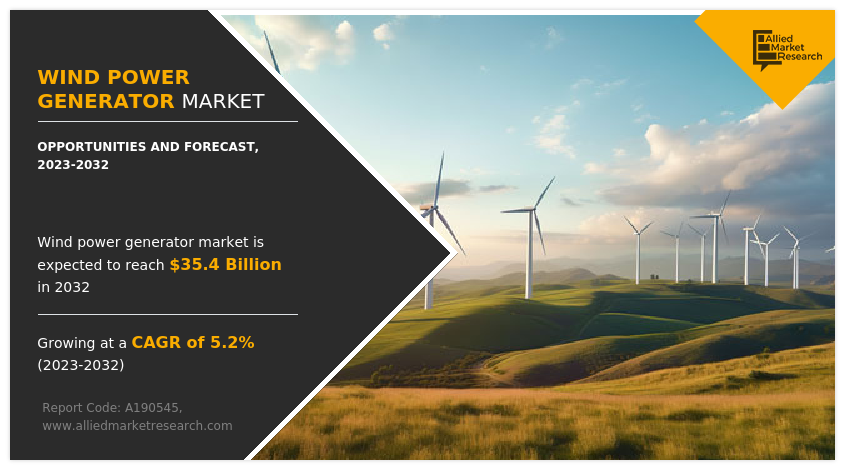
A wind power generator, also known as a wind turbine or wind energy converter, is a device that converts wind energy into electrical power. Wind turbines harness the kinetic energy of the wind and transform it into mechanical energy, which is then used to generate electricity. They are a clean and renewable energy source, as they do not produce greenhouse gas emissions or consume finite resources.
The global shift towards cleaner and more sustainable energy sources to combat climate change and reduce greenhouse gas emissions has led to a growing demand for renewable energy, including wind power. Wind energy is seen as a crucial component of the clean energy transition, and governments, businesses, and consumers are increasingly supporting its adoption.
In addition, governments globally have implemented supportive policies and incentives to promote the development and deployment of wind power generation. These may include feed-in tariffs, tax credits, grants, and renewable energy mandates, which make wind energy projects more financially attractive for investors and developers. These factors are expected to propel the growth of the wind power generator market.
However, connecting wind power projects to the electrical grid, particularly in remote areas with abundant wind resources, can be logistically and financially challenging. Transmission lines may need to be extended or upgraded, adding to the overall project costs. This factor is projected to restrain the market growth.
On the contrary, advancements in smart grid technologies and grid management systems facilitate the integration of intermittent renewable energy sources such as wind power into the existing power grid. Improvements in grid flexibility and management enhance the ability to accommodate higher levels of wind power penetration, creating new opportunities for wind energy expansion. This is anticipated to increase sales of wind power generators in several end-use sectors; thus, creating lucrative opportunities for the wind power generator market forecast.
The wind power generator market is segmented on the basis of installation, application, end-use industry, and region. On the basis of installation, the market is categorized into on-shore and off-shore. On the basis of application, the market is categorized into horizontal axis wind power generator and vertical axis wind power generator. On the basis of end-use industry, it is divided into commercial and industrial, utility and power generation, and others. Region-wise, the market is studied across North America, Europe, Asia-Pacific, and LAMEA.
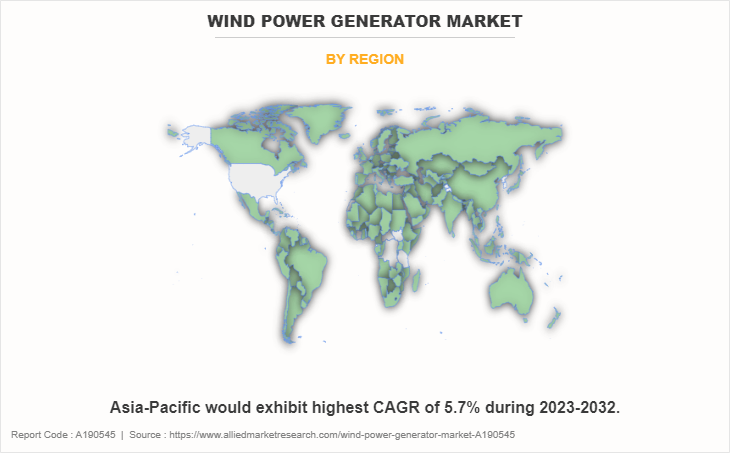
The Asia-Pacific wind power generator market size is projected to grow at the highest CAGR of 5.7% during the forecast period and account for 44% of wind power generator market share in 2022. The China government is actively promoting renewable energy as part of its efforts to reduce pollution and carbon emissions. Supportive policies, such as feed-in tariffs, subsidies, and renewable energy targets, boost wind power development. China seeks to diversify its energy mix to enhance energy security and reduce dependence on coal.
Air quality and environmental concerns have motivated China to transition toward cleaner energy sources such as wind power. Wind power generators are gaining traction as a more environmentally responsible packaging solution. India is actively exploring diverse energy sources, including wind power, to meet its requirements. Wind power's declining costs and competitive tariffs make it an attractive option for addressing India's energy needs. Wind power projects have provided income to rural communities through land lease agreements and job opportunities
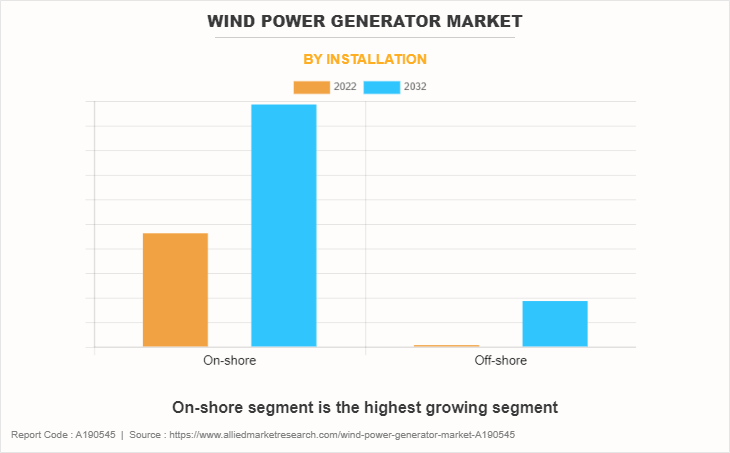
By installation, the on-shore segment dominated the global market in 2022, and is anticipated to grow at a CAGR of 5.4% during the forecast period. Onshore wind installations generally have lower upfront costs as compared to offshore installations. The costs associated with transporting and installing offshore wind turbines in water are often higher, making onshore projects more financially feasible. This factor is expected to enhance the wind power generator market for onshore segment during the forecast period. Many regions have significant onshore wind resources that can be harnessed for electricity generation. Favorable wind conditions make onshore installations a practical choice for producing renewable energy.
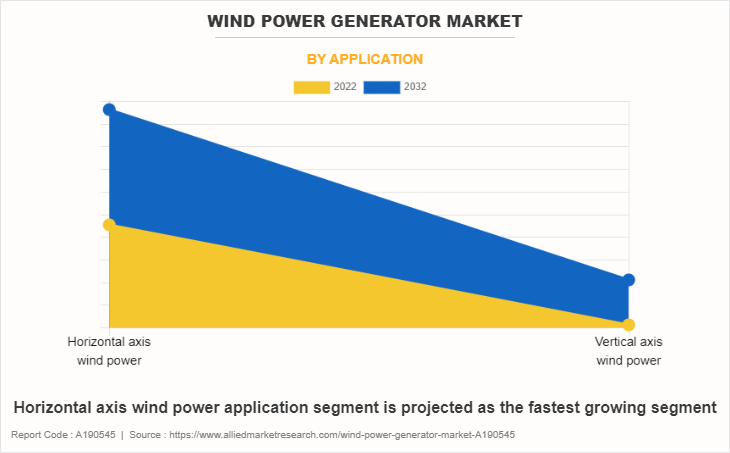
By application, the horizontal axis wind power generator segment dominated the global market in 2022, and is anticipated to grow at a CAGR of 5.3% during the forecast period.‐¯ Advances in manufacturing, materials, and design have led to cost reductions in HAWT production and installation, enhancing their cost competitiveness as compared to other renewable energy sources. Global efforts to transition from fossil fuels to clean energy sources have led to increased interest in renewable energy technologies such as HAWTs. Many governments offer incentives, subsidies, and supportive policies to encourage the installation of wind power generators, including HAWTs. The wind energy sector, including HAWT installation, operation, and maintenance, creates jobs in manufacturing, construction, and other related industries.
Furthermore, technological advancements, such as ongoing advancements in materials, aerodynamics, and control systems continue to improve the efficiency and performance of HAWTs. HAWTs are well-suited for integration into existing electricity grids, helping to meet energy demand and stabilize the grid. Increased public awareness of environmental issues and the benefits of renewable energy sources has led to growing support for wind power installations.
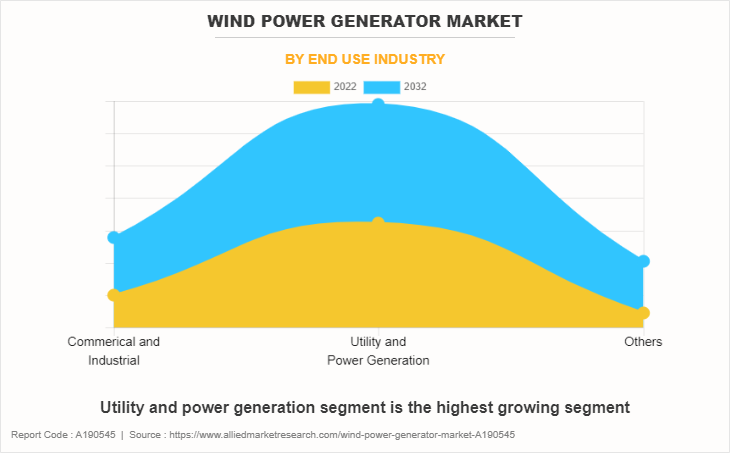
In 2022, the utility and power segment was the largest revenue generator, and is anticipated to grow at a CAGR of 5.4% during the forecast period. Utility-scale wind farms consist of multiple wind power generators, grouped together in a specific area. These wind farms can produce a substantial amount of electricity that is fed into the grid and distributed to consumers.
Wind power generators contribute to the generation of renewable energy, helping utilities meet their renewable energy targets and reduce carbon emissions. Wind power generators can provide electricity during peak demand periods, helping to stabilize the grid and reduce the need for expensive peaking power plants. Utilities integrate wind power generators to diversify their energy mix, reducing reliance on fossil fuels and enhancing energy security.
In regions with consistent and strong wind resources, wind power can serve as a reliable source of base load generation, complementing other forms of power generation.
The global wind power generator market profiles leading players that include Siemens, GE, Vestas, Goldwind, Enercon, Samsung Electronics, United Power, Inc., Ming Yang, Senvion, and Nordex Group.
Other key players include, Mitsubishi Heavy Industries, Repower, Alstom, Sinovel Wind Group Co Ltd., and Orano. The global wind power generator market report provides in-depth competitive analysis as well as profiles of these major players.
Impact of Russia Ukraine War on the Wind Power Generator Market
- Sanctions or trade restrictions are imposed on any of the involved countries, it has affected the international trade of wind power equipment and components, potentially leading to price fluctuations and supply chain challenges.
- Geopolitical events often draw significant media attention. Increased coverage of conflicts could also raise public awareness about the importance of transitioning to sustainable and renewable energy sources have enhanced the wind power generator market scope during the forecast period.
Key Benefits For Stakeholders
- This report provides a quantitative analysis of the market segments, current trends, estimations, and dynamics of the wind power generator market analysis from 2022 to 2032 to identify the prevailing wind power generator market opportunities.
- The market research is offered along with information related to key drivers, restraints, and opportunities.
- Porter's five forces analysis highlights the potency of buyers and suppliers to enable stakeholders make profit-oriented business decisions and strengthen their supplier-buyer network.
- In-depth analysis of the wind power generator market segmentation assists to determine the prevailing market opportunities.
- Major countries in each region are mapped according to their revenue contribution to the global market.
- Market player positioning facilitates benchmarking and provides a clear understanding of the present position of the market players.
- The report includes the analysis of the regional as well as global wind power generator market trends, key players, market segments, application areas, and market growth strategies.
Wind Power Generator Market Report Highlights
| Aspects | Details |
| Market Size By 2032 | USD 35.4 billion |
| Growth Rate | CAGR of 5.2% |
| Forecast period | 2022 - 2032 |
| Report Pages | 247 |
| By Installation |
|
| By Application |
|
| By End Use Industry |
|
| By Region |
|
| Key Market Players | Goldwind, Ming Yang Smart Energy Group Limited, General Electric, NORDEX SE, Siemens, Senvion, Samsung Electronics, United Power, Inc., ENERCON GmbH, Vestas |
Analyst Review
According to CXOs of leading companies, the global wind power generator market is expected to exhibit high growth potential during the forecast period. This is attributed to a significant surge in demand for wind power generator from residential and commercial end-users. Wind power generators are extensively used in hospitals, hotels, hostels, schools, educational institutions, and restaurants for utility purposes. In addition, rise in concerns from governments across emerging nations, such as China, India, and South Korea, regarding zero emission norms is expected to drive the market growth. Governments across different countries implement new rebate and energy schemes on excess amount of energy for residential as well as commercial users. This is expected to enhance the market penetration in new customer segments.
The CXOs further added that sustained economic growth and the development of the residential & commercial sector have surged the popularity of wind power generator market.?
Companies were increasingly prioritizing sustainability and environmental responsibility. This trend influenced decisions throughout the value chain, from turbine manufacturing to project development and operation.
Horizontal axis wind power generator is the leading application of wind power generator market.
A wind power generator, also known as a wind turbine or wind energy converter, is a device that harnesses the kinetic energy of the wind and converts it into electrical power. Wind turbines are a crucial component of wind power systems, which generate renewable energy from the wind, a clean and sustainable resource. In addition, Wind power generators are available in various sizes, from small turbines used for residential or rural applications to large-scale utility-grade turbines installed in wind farms. The efficiency and energy output of wind turbines depend on factors such as wind speed, turbine size, design, and location.
The wind power generator market is segmented on the basis of installation, application, end-use industry, and region. On the basis of installation, the market is categorized into on-shore and off-shore. On the basis of application, the market is categorized into horizontal axis wind power generator and vertical axis wind power generator. On the basis of end-use industry, it is divided into commercial and industrial, utility and power generation, and others. Region-wise, the market is studied across North America, Europe, Asia-Pacific, and LAMEA.
The global wind power generator market was valued at $21.4 billion in 2022, and is projected to reach $35.4 billion by 2032, growing at a CAGR of 5.2% from 2023 to 2032.
Siemens, GE, Vestas, Goldwind, Enercon, Samsung Electronics, United Power, Inc., Ming Yang, Senvion, and Nordex Group.
Asia-Pacific is the largest regional market for Wind Power Generator?
Loading Table Of Content...
Loading Research Methodology...



